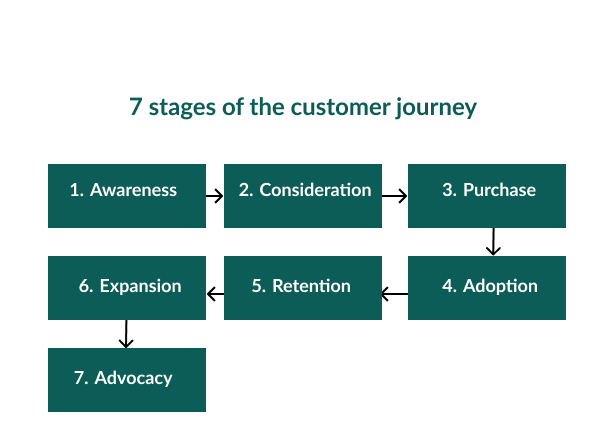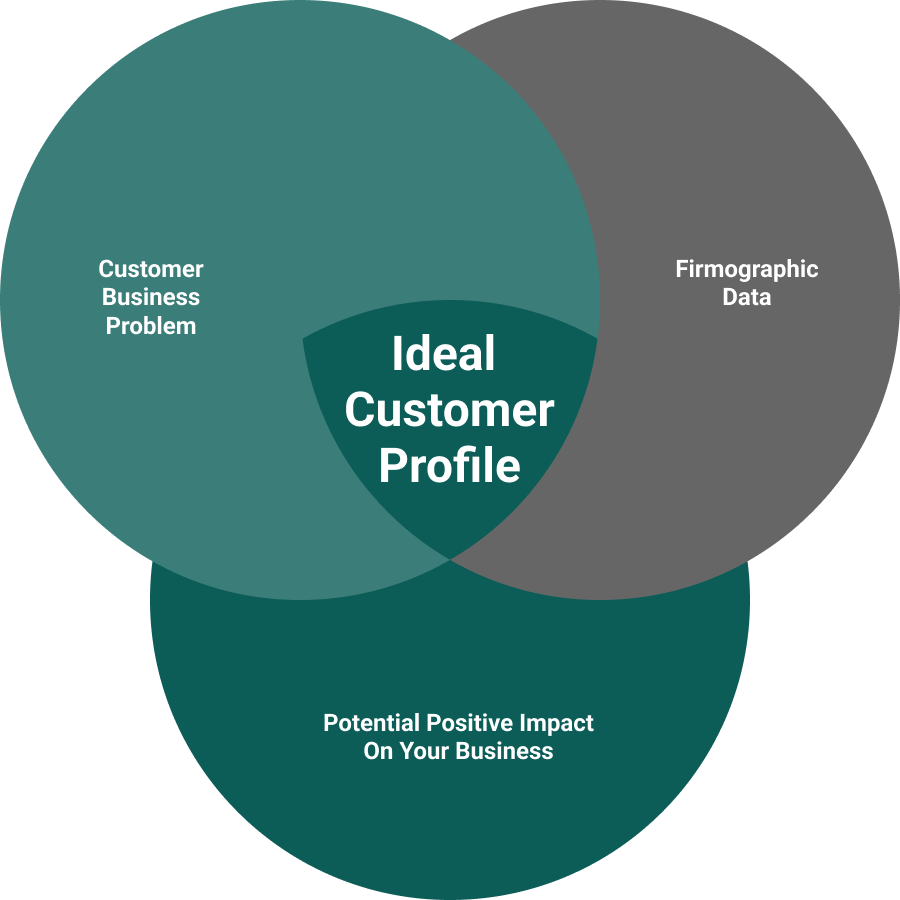Retaining your customers should be one of your top priorities as a business.
Not only can it cost five times as much to land a new customer than to retain an existing one, but you have a 70% chance of selling more to that existing customer, too.
You see, most people think it’s the job of customer success to retain customers, and that support and service teams should be responsible for keeping customers happy.
But have you considered how your sales team can influence more than just the initial sale and make a positive impact on the wider customer journey?
In this article, we’ve outlined exactly how your sales team can lay the foundations for customer retention that will deliver results later in the customer journey.
What is the customer journey?
The customer journey is the name given to the 7 different stages your customers will go through while doing business with you.

It spans the overall lifecycle of your customers across both pre-sales and post-sales and includes the following steps:
Pre-sales
1. Awareness – making sure the right people know about your product.
2. Consideration – helping them to choose your product vs others.
3. Purchase – closing the sale and winning the deal
Post-sales
4. Adoption – ensuring your customers use your product and get value from it.
5. Retention – keeping your customers using your product and paying for it.
6. Expansion – growing the value of your customer’s account through upsells.
7. Advocacy – developing your best customers into brand advocates who refer others.
The overall goal of the customer journey is to design an experience that helps you retain your customers, expand the value of their accounts over time, and turn them into advocates.
Your sales team can influence way more than the initial sale
B2B buyers spend only 5% or 6% of their time with your sales reps during the consideration and purchase phases of their journey – so every minute matters.

Retaining the right customers throughout the customer journey is critical to business success, and your sales team is perfectly placed to set the tone.
To help you understand exactly what we mean, we’ve outlined multiple ways your sales team can influence the wider customer journey to retain and expand your customers in the long-term.
However, before your sales team can start to really impact the rest of the customer journey, it’s important to do some groundwork, first.
Laying the foundations for influence across the customer journey
Sales teams shouldn’t operate independently from the rest of your business.
Instead, they should be closely aligned with the rest of your ‘go to market’ function.
‘Go to market’ includes sales, marketing, and service to ensure a cohesive approach to targeting, selling, and servicing the right kinds of customers for your business.
A great tool to ensure alignment is an ICP, or ideal customer profile – a set of criteria that outlines the profile of customers who are a good fit for your business.

An ICP uses historical CRM data to determine the types of customers who are easy to support, have scope to expand, are profitable to serve, and remain with you long-term.
The best-performing companies will align their entire customer journey against ideal customer profiles to maximize their chances of building long-term customer relationships.
By taking the time to make sure marketing, sales, and service are all working in unison to work with “good fit” customers who match your ICP, your business can avoid:
- Wasting time trying to convince “bad fit” customers and extending the sales cycle.
- Issues around price sensitivity and difficulty in expanding their accounts over time.
- Sinking too much time and effort into supporting ‘bad fit’ customers.
- The risk of these customers churning quicker than expected.
Once sales and marketing teams are aligned, your sales teams can use a wide range of tactics to influence the customer journey across pre-purchase, purchase, and post-purchase stages.
Let’s take a closer look at each stage.
How sales teams can influence the customer journey
PRE-PURCHASE
Aligning your sales and marketing teams to target the right kinds of customers is critical for your overall business success. But that’s not all your sales teams can do pre-purchase!
Your sales teams can also leverage their insights and relationships to improve their chances of closing more deals with more of the right customers.
What do we mean by that?
There are 3 ways that your sales team can impact the customer journey pre-purchase:
1. Influencing the market
Today, 90% of B2B buyers turn to online channels to identify potential new suppliers, and while that typically includes looking at between 2 and 7 websites, that’s not all.
Content is key to persuading and influencing potential customers to become buyers. Most B2B buyers consume 7 or more pieces of content before making a purchase decision.
Content doesn’t just mean articles, videos, or downloadable PDFs. It also means social media content. And in B2B, social media doesn’t come bigger than LinkedIn.
Encouraging your sales team to post on LinkedIn can have an incredible impact on your overall customer journey.
At the very top of the funnel, the right LinkedIn post can help prospects quickly move through the stages of awareness and ultimately become brand-aware.
Meanwhile, as prospects start engaging with potential suppliers, seeing high-quality, relevant, and informative content on LinkedIn can help build trust and sway their decision.
But what kinds of content can your sales team share on LinkedIn to help influence the customer journey?
- Statistics or stories about how their product solves a significant business problem.
- Insights into how the market is moving, helping buyers understand their options.
- Tips or “how to” content to help position themselves as experts in the sector.
Posts like these are a great way to become visible and start to build relationships with potential customers at scale.
Once these relationships are in place and the sale has been closed, how else can sales teams use them further to influence the pre-purchase parts of the customer journey?
2. Turning relationships into reviews
Your sales team is in the perfect place to build great relationships with your customers.
They take the time to build rapport, listen to their needs, and devise solutions, helping to build strong bonds that can last far beyond the initial deal.
As a result, your sales team can leverage these relationships into tangible outcomes that can help influence pre-purchase for other customers in the future.
How can they do that?
By seeking reviews for platforms like G2 and Capterra, as well as for your own website.
Reviews like this matter – for industries like software, for example, 98% of B2B buyers seek out (and are influenced by) online reviews.
They don’t just read reviews, though. 84% of people see online reviews as equal to a word-of-mouth recommendation from friends and family.
This means that encouraging your sales team to collect reviews from customers they have great relationships with can have a huge future influence on pre-sales.
But that’s not all – the more they do this, the bigger impact it will have, helping to see compounding results over time.
3. Providing feedback to the marketing team
Because your sales team is actively involved in dealing directly with your customers, they can easily gather highly valuable insights that can influence the customer journey.
When it comes to feedback that can impact the pre-purchase stage of the customer journey, sales teams are perfectly placed to provide your marketing team with intelligence on:
- Pricing: Are customers responding well to how your products and services are priced? Is your pricing too high and preventing sales? Are you too cheap and losing out on revenue?
- Lead quality: Are your MQLs of sufficient quality to close deals? Are the leads aligned with the ICPs you’re supposed to be selling to? Is a specific channel delivering better leads?
- Collateral: Do your customers have access to the right content pre-purchase to influence their decision? Are there requests for certain content you hear repeatedly from prospects?
- Messaging: Does the marketing messaging on your website and advertising set the right expectations for prospects? Is it clear? Are customers confused? How could it be improved?
Offering this type of feedback means that your sales team is improving the pre-purchase stage of the customer journey and making their future jobs easier, too.
PURCHASE
To maximize the impact of your sales team on this stage of the customer journey, you should strongly consider giving them a structured sales process to work on.
There are 4 ways to add further structure to your sales process, particularly when using a CRM like SuperOffice.
1. Guides and playbooks
Using guides and playbooks to document and roll out key sales processes is a great way to keep your sales team on the same page – literally.
More than this, though, using sales playbooks also gives you the opportunity to influence the purchase phase of the customer journey directly. They enable you to do this by:
- Helping keep your voice, strategy, and positioning consistent
- Ensuring your sales team sticks to approved best practices each time
- Equipping your team with a standardized approach that’s proven to work
Having these building blocks in place allows you to offer your customers a “best in class” sales experience that will boost the number of deals you close.
2. Integrations for better experiences
Your sales team and customers are most effective when they’re armed with tools they already know how to use.
This is why integrating your sales processes and CRM with tools you already know and love can greatly influence your customer journey's effectiveness. For example:
- Creating CRM activities and notes directly from customer emails
- Using your calendar to share your availability for calls with customers
- Sending your customers helpful documents using tools like SharePoint
Easily controlling and contributing to the overall customer experience using tools you’re already familiar with will help you close more sales and better serve customers.
3. Use data to your advantage
Sales teams understand that high-quality, centralized data is the key to B2B sales success.
Refining data into dashboards will help you understand several key customer journey outcomes and give you the insights you need to improve them.
By leveraging and visualizing data as dashboards in your CRM, you can learn things like:
- How deals are progressing, pipeline values, and open sales.
- How you’re performing now vs. the last quarter
- How many deals are at risk and require a more strategic approach
Using this data to your advantage can help you improve the success of the purchase part of the customer journey in the long term and close more sales right now.
4. Make sales more intelligently
Data is great, but it becomes really powerful when combined with sales intelligence technology.
Choosing a CRM with sales intelligence features gives you unparalleled control over how you interact with customers.
Staying ahead of the game using sales intelligence means that you can monitor your database and automatically schedule things like:
- Follow-ups that’ll help you close the deal
- Renewals that’ll keep your customers retained
- Sales-related activities relevant to specific customers
In doing so it helps to create a positive experience for your customers and gives the impression that you are reliable, trustworthy, and good to work with.
All of this will help close the sale and influence the number of customers who continue their journey with your company after the sale.
POST-PURCHASE
The final piece of the customer journey includes adoption, retention, expansion, and advocacy, and they are critical to your business's long-term success and growth.
Sales teams can take 2 key actions to have the most influence over this phase of the customer journey and ensure as many of their customers stay as possible.
1. Create smooth handovers for the customer success team
You need to focus on creating incredible handovers between sales and customer success teams.
In doing so, you’ll set your customer success team up with all the information they need to ensure this new customer thrives in your business.
All too often, sales teams see handovers as an afterthought. Instead, try having a structured process that can include:
- Bringing CSMs into the sales conversation early
- Introducing customer success as the deal closes
- Documenting the customer’s needs and goals
- Feeding back directly to your CS team exactly why you signed this customer
- Including the customer in the handover process to make it more collaborative
You will quickly realize it’s a critical way of influencing the entire customer journey.
2. Gather feedback from new customers
The best sales and customer service processes are repeatable and measurable, which means you should be able to gather customer feedback on them.
Collecting these customer insights means you can improve your operations moving forward and create an even better experience for future customers.
Areas that sales teams can collect data on that will directly influence the post-purchase part of the customer journey include:
- Customer Effort Score – how easy was it to go from sales to onboarding?
- Net Promoter Score – how likely are they to recommend you to friends and family?
- Customer Satisfaction – how was the sales process? How was onboarding? etc.
In doing so, they’ll also be able to understand customers who may be at risk, as well as bad-fit customers who have potentially slipped through the net.
This enables a sales team's influence on the customer journey to go completely full circle from ICP to post-purchase and back again.
How a CRM platform can help your sales team influence your entire customer journey
At SuperOffice, we believe that better business relationships are the key to retaining customers.
Building high-quality, authentic customer relationships starts during the sales process and continues across the customer journey.
Focusing your sales team on doing everything they can to set your customers up for success across the journey is a critical piece of the retention puzzle.
In doing so, you can expect incredible outcomes like:
- An increase in customer satisfaction
- A reduction in customer churn levels
- The opportunity to authentically expand customers
- A strong foundation for revenue growth
Until now, asking your sales teams to influence the customer journey and then tracking that impact was challenging.
CRM software now makes it easy to measure the success of every customer interaction and track their progress across the customer journey.
Ready to retain and grow customers across the customer journey with SuperOffice CRM?
Book a demo of SuperOffice today and learn how your sales, marketing, and service teams can all influence the customer journey from one CRM platform.



